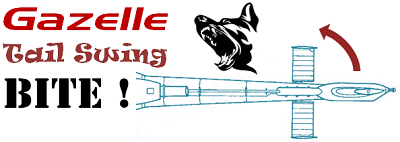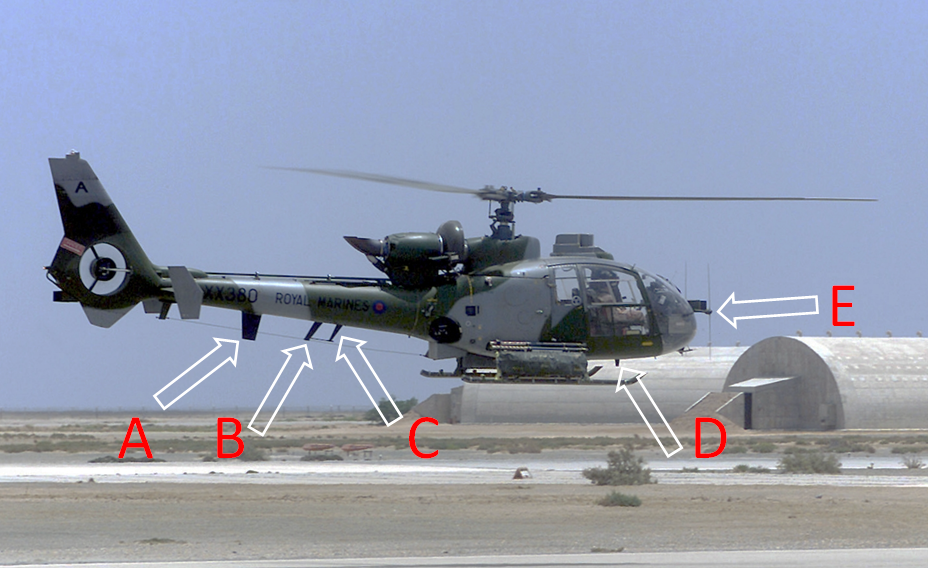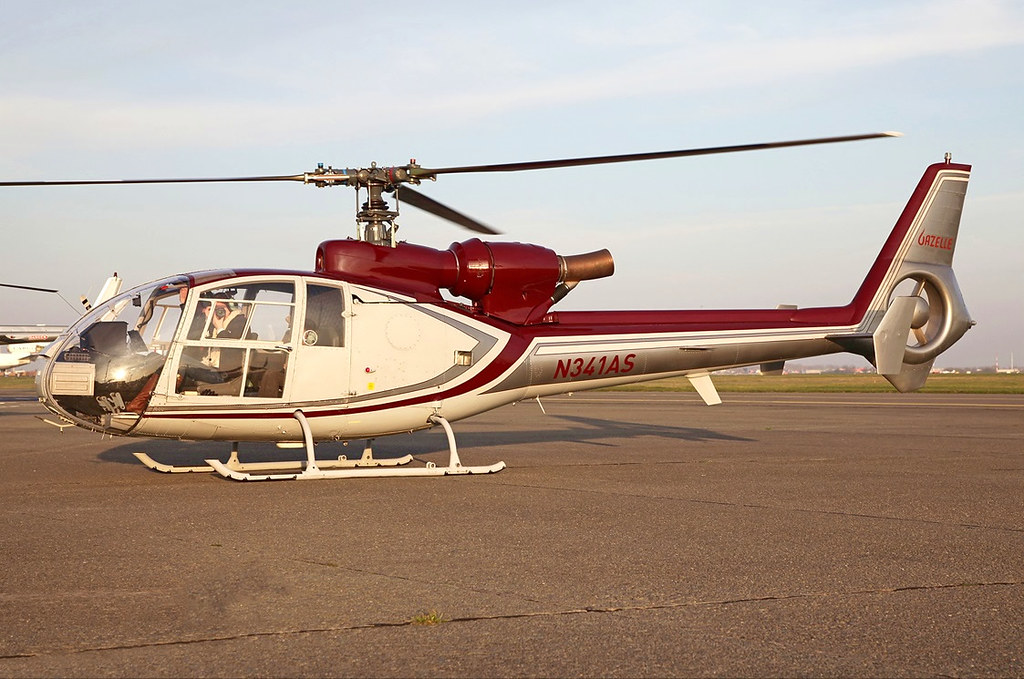Announcement
Collapse
No announcement yet.
Shrieking Gazelles
Collapse
This topic is closed.
X
X
-

As Zis has recently raised the issues of ‘Jack Stall’ and ground resonance .. I thought it may be an idea to highlight that ‘other’ Gazelle issue which I refer to as the ‘Tail Swing Bite!’
This phenomenon is also known as ..
- Loss of tail rotor effectiveness
- New Gazelle pilot's syndrome
- Not knowing one’s left from one’s right
- Fenestron stall
Over the course of some weeks I read an entire Gazelle thread on another forum in which those with experience on Gazelles discussed this phenomenon. These were some of the comments:
“Beware of Fenestron Stall.”
“Fenestron Stall does not exist.”
And in regard to ‘Fenestron Stall’ and its prevention:
“Safer to fly with SAS on.”
“Safer to fly with SAS off.”
And so it went on with page after page of contradictory opinion which begged the question .. what are the facts?
At which point I thought “let's see what the AAIB reports have to say about this” .. so here are some of the excerpts:
1) SA341G YU-HEW JAN 2008
Pilot Experience
Total Experience (Helicopter): 56
Total Hours (On Type): 46
Comments from Accident Report
Injuries from AccidentIn the absence of any significant technical defect, it is considered that the pilot lost control of the helicopter in yaw due to the strength, direction and gusty nature of the wind acting on the aircraft whilst flying at low forward airspeed.
However, it is considered that the main contributing factors to this accident were the pilot’s lack of experience and probable inadequacies in his training.
Two fatalities.
AAIB Accident Report
2) SA342J F-GJSL MAY 2005
Pilot Experience
Total Experience (Helicopter): 600
Total Hours on Type: 12
Comments from Accident Report
Injuries from AccidentPilots who are inexperienced on the Gazelle need to be particularly aware of this apparent loss of tail rotor control. Unlike several helicopter types routinely used for training, the man rotor rotates in a clockwise direction (when viewed from above) and right pedal rather than left pedal is needed to oppose main rotor torque.
Also, the fenestron-equipped Gazelle requires greater pedal deflection than that required for manoeuvring other training helicopters. Additionally, the tail fin is considerably larger than non-fenestron equipped helicopters, leadng to more challenging spot turns in windy conditions. In view of these characteristics, the statement in the MoD FM of: "Whenever possible, the first turn should be made to the right to check the maximum rotor torque required.”
Two seriously injured.
AAIB Accident Report
3) Westland Gazelle HT2 G-BZOS JUL 2002
Pilot Experience
Total Experience (Helicopter): 167
Total Hours on Type: 21
Comments from Accident Report
Injuries from AccidentThe pilot anticipated the need for right yaw pedal during the takeoff, but just after becoming airborne the helicopter yawed to the left and despite the use of more right yaw pedal, the rate of yaw increased. As the aircraft passed through 180° the rate of yaw was too high to land and the pilot became confused. He applied right cyclic to try to counter the yaw but the aircraft rolled to the right and the main rotor blades struck the ground.
Both the Eurocopter Service Letters and the Ministry of Defence Flight Manual emphasise that very high yaw rates can rapidly develop in the hover in light wind conditions with only very small applications of left yaw pedal.
Two persons with minor injuries.
AAIB Accident Report
4) Westland Gazelle HT3 G-BXZE
Pilot Experience
Total Experience (Helicopter): 180
Total Hours on Type: 2
Comments from Accident Report
Injuries from AccidentThe pilot reported that the wind was calm and he lifted to a hover about 6 to 8 feet above the ground. He began a left pedal turn to position the helicopter for transition over the open arena area to the east. As the turn approached 180° from the initial heading, the pilot felt that he was unable to stop the helicopter turning left. The rate of turn began to increase
rapidly.
After some 10 to 12 rotations, the pilot elected to land the helicopter immediately while still turning rapidly to the left. On touchdown, the right skid broke and damage was sustained during the rotational deceleration.
EUROCOPTER remind you that in some configurations (hover flight, flight at low speed in light wind etc), starting a turn to the left can induce a high-rate turn if the pilot does not apply quickly the suitable position to the yaw pedal. If the pilot attempts to counter this high-rate turn by applying the amount of right yaw pedal.
One person with minor injuries.
AAIB Accident Report
5) SA341G G-BCHM JUL 1997
Pilot Experience
Total Experience (Helicopter): 68
Total Hours on Type: 29
Comments from Accident Report
Injuries from AccidentThe initial lift-off was normal but at a height of about 3 feet the helicopter yawed to the left. The pilot believes that he took the necessary corrective actions with the yaw pedal but the left yaw continued through approximately 2 revolutions with the helicopter climbing to about 9 feet and rolling to the right. The pilot elected to carry out an immediate landing by lowering the collective lever. Ground contact was firm but the helicopter remained upright and came to rest on the original take-off heading.
It is therefore most likely that the helicopter suffered the sudden loss of yaw control which can occur in the Gazelle in light wind conditions.
No serious injuries.
AAIB Accident Report
6) SA341G G-HAVA JUL 1997
Pilot Experience
Total Experience (Helicopter): 170
Total Hours on Type: 25
Comments from Accident Report
Injuries from AccidentThe wind was from the left and the intended departure directionwas to the west. The pilot was therefore conscious of the need to turn to the left after take off and may inadvertently have applied left pedal during the take off process. The helicopter's behaviour would then have been consistent with the skid marks indicative of it yawing whilst still in ground contact and with witness descriptions of it turning immediately on leaving the ground. Conditions would then have been conducive to the rapid increase in yaw rate experienced in other Gazelle accidents and incidents, particularly if the wind had been modified by adjacent hangars to provide a less favourable local wind component from the right. It is therefore likely that the pilot experienced a sudden loss of yaw control induced by her early left pedal input.
It is therefore recommended that the Civil Aviation Authority (CAA) reconsider the type-rating training requirements for the Gazelle to determine whether additional emphasis needs to be placed on yaw control during take off, landing and low speed manoeuvres.
Two persons seriously injured.
AAIB Accident Report
7) SA341G G-TURP SEP 1991
Pilot Experience
Total Experience (Helicopter): 108
Total Hours on Type: 9
Comments from Accident Report
Injuries from AccidentThe Gazelle has a history of suffering unexplained loss of fenestron effectiveness, commonly known as ‘fenestron stall’. Know previous cases include .. 11 accidents plus 11 incidents in the UK military fleet. The majority of documented ‘fenestron stalls’ have occurred in the hover during an attempted left turn in conditions of wind speeds of 10 kts+ from astern or from the right but there have also been cases in a variety of other wind and flight conditions.
No serious injuries.
AAIB Accident Report
8) SA341G G-SFTA MAR 1984
Pilot Experience
Total Hours (Helicopter): 6,000
Total Hours on Type: 120
Comments from Accident Report
Injuries from AccidentThe helicopter took off from Carlisle Airport at 0800 hrs on a navigational training sortie which was to simulate the pick-up of troops at various points on the route. About 18 mins after take-off the student had identified a pick-up point near a barn and was told by his instructor to look for a suitable landing area. They flew past the barn at 40-50 kts with a slight left bank at about 100-150 ft agl. The helicopter started to yaw to the left at an increasing rate with the airspeed reducing. The instructor reached for the controls and asked the student what he was doing. The student replied that he had lost control. By now despite the full right pedal and forward cyclic applied by the instructor the helicopter was rotating to the left and descending. The instructor raised the collective just before the helicopter hit the ground nose down and right skid low. The helicopter, after contacting the ground., rolled over onto its right side.
No serious injuries.
AAIB Accident Report
From these reports it seems to me that the UK’s AAIB and CAA both believe in the existence of ‘Fenestron Stall’ (even if that isn’t the best phrase to describe it).
I think the moral of the story may be to ensure that new Gazelle pilots are thoroughly acquainted with the potential for the Gaz to deliver an unwanted ‘tail swing bite’ .. and for the need to be aware of those conditions which can induce this.
Comment
-
The Gazelle POH says: ALWAYS TURN RIGHT.
Of course the helicopter can also turn left, but some aggressive pilots might turn the helicopter too aggressively to the left and run out of right pedal to stop the movement. In this case, maintain full right pedal until the revolutions stop. It can take 2-3 revolutions to stop the helicopter from turning.
More likely to have this phenomenon with the 'non-upgraded fenestron'. All MIL Gazelles have the upgraded fenestron. Most civil 341 Gazelles have the early type. 342s have the upgraded fenestron also.
Comment
-
This is what I had been told.Originally posted by xbdt View PostIt can take 2-3 revolutions to stop the helicopter from turning.
You may imagine my surprise then when I read in the accident report for G-BXZE (No. 4 above) ..
Could you describe the difference/modifications which are associated with the upgraded fenestron?After some 10 to 12 rotations, the pilot elected to land the helicopter immediately while still turning rapidly to the left.
Comment
-
NON upgraded:

Upgraded:

Look at the root of the blades. The blades are rounded and are fitted in what they call bearings, but these are plastic bushings.
Besides this there is no gap between the blades; this makes a less turbulent airflow thus more effective.
To upgrade the fenestron you'll need a new strap pack, 'bearings' and blades and it will cost you about €50k.
Also the non upgraded blades have more a standard flat blade design, the upgraded blades have more the shape of a wing.Last edited by xbdt; 17th July 2015, 13:40.
Comment
-
XB, many thanks for this explanation!
So, just to recap, Aérospatiale basically reset the fenestron blades into a flush-mounted one-piece rim attached to the fenestron hub .. and the resulting 'cleaner' airflow created an improvement in the fenestron's thrust?
Imagine the additional thrust they could have gained had they also increased (at least slightly) the chord on the fenestron blades!
Comment
-

Strictly speaking .. this news isn't so up-to-date as it is from November last year. However .. in the world of nostalgia .. that's fairly recent!
http://www.sanparks.org/about/news/default.php?id=55944Anti-Poaching Gazelle Donated to Kruger National Park in South Africa
The South African National Parks (SANParks) today unveiled the GAZELLE – a military spec helicopter – that will bolster their current fleet involved in Anti-Poaching. The event was held at the Letaba shooting range.
“With the GAZELLE now part of the SANParks Anti-Poaching operations we hope that the fight for the rhino will reach a tipping point in 2014. I want to reiterate what I said this time last year, we will not stand by and watch our rhino’s be slaughtered and are sick and tired of unscrupulous criminals taking advantage of our natural heritage” said sponsor Ivor Ichikowitz.
The helicopter will be based in Phalaborwa and will assist rangers with reaction times in responding to poaching violations in the north of the park.

The Kruger National Park's new Anti-Poaching Unit helicopter - an SA341B Gazelle
The aircraft was delivered to South Africa on the UK register as G-CHMF, a former Army Air Corps Gazelle, ZB688 cn 1999.


Comment
-
I'm back!
Excuse my silence, I was offline the past two days.
I see you two were productive while I was absent. Well done!
Well done!
Xbdt: Interesting pics of C-GDUG's cabin. Thnx!
If I may say, you were lucky when you got that interior. What if you got something like this:

A pimp's coffin, LOL!
Somebody said the 1970's were years with taste ... in music maybe, but obviously not as far as helicopter interiors were concerned.
Savoia: Nice overview regarding FenStall. Looks like Aviafora is becoming a reference place for Gazelle helicopters!
Here are some close-ups of fenestron blades:


Comment
-
It seems you're right:Originally posted by xbdt View PostAlso all french ex-military Gazelles are sold by the government and exported out of Europe. AH they do not want to see it flying in Europe as they prefer to sell new aircraft.

http://www.janes.com/article/29173/n...les-two-su-25sAdmiral Édouard Guillaud, the French Chief of Defence staff, has inaugurated a new hangar for the three Gazelle helicopters that France has donated to the Nigerien Air Force.

French Chief of Defence staff Admiral Édouard Guillaud poses with Nigerian pilots in front of a Gazelle helicopter on 17 October 2013
The French Ministry of Defence website said the ceremony was held on 17 October at Niger's Base Aérienne 101, which is next to Niamey's international airport.
The Nigerien media reported in April that the helicopters were delivered in January and are armed with 20 mm guns. The French also trained six Nigerien pilots with more being trained in the near future, according to the report.
Comment
-
Thanks for the background on F-GOSO.
Re: Gazelle antennas .. I'm not entirely sure but I suspect one of the 'fin' style types (mounted on the underside of the tailboom) may well be an ADF antenna (although quite different from the ADF antennas used on the 206 and 500 and which tended to be oval and flat).
The 'line' aerial/antenna shown on the Royal Marines Gaz is most likely an HF aerial.
Confirmation would be good though!
Comment
-
Regarding antennas:
- under Belly (mostly oval): ADF
- under middle of tail boom (large fin shape): VHF
- inside tail boom (or long cable from rear cabin to rear tail boom): HF/SSB
- left and right side of tail boom (sometimes center, sometimes more aft): VOR ando/or DME
- front of nose (2 verticals on each side, on MIL aircraft): Homing antennas
- under nose (rare, small fin): UHF
- under nose, on top of cabin or inside vertical fin (just under the upper tail cover): GPS
- on tailboom, position not standardised: ELT 121.5, 406 or both
Comment
-
Well done XB!
Zis, based on XB's comments I am assuming the following:
A - VHF Antenna
B - HF/SSB Aerial (The 'fin' is [I imagine] to stabilise the wire, ie. to accommodate the wire mounting)
C - I think this may be a VOR Antenna (not connected to "B" above) and which has two smaller aerials trailing in a 'v' shape
D - UHF Antenna
E - 'Homing' Antenna

Can anyone say any more about the homing antenna on the front? Is this for tracking ELT's?
Comment
-
F-GEQA is G-OGAZ these days:

These aircraft are 40 years old; so many people worked on these and made so many mods that it is really difficult to know the history of each aircraft.
I think below the tail there are 2 fins for the VHF comms. On each side if the t/b there is a VOR antenna. Below, there is a HF wire. On top of the vertical fin, could be a homing antenna (not sure about this).
Comment
-
I found it a little difficult to define the shape of the antenna, the mounting arrangement seems a little different. I am tempted to say that it could be a GPS antenna (despite the seemingly inappropriate location) but .. I am not certain.Originally posted by Zishelix View PostI wonder what kind of antenna is this one under the landing light?
More Gaz tales ..
G-VOIP manoeuvering at Castellón Airport in the east of Spain.
Notice how keen the Gaz is to comply with the left pedal command. Like a bronco waiting to be let loose from its stall at a rodeo!
Comment






















Comment